Trees Birds Mammals Fish Amphibians Reptiles
Wild Algarve
Bookshop
Microglossum pratense V. Kucera, Lizon & Tomsovsky
Phylum: Ascomycota - Class: Leotiomycetes - Order: Leotiales - Family: Leotiaceae
Distribution - Taxonomic History - Etymology - Identification - Culinary Notes - Reference Sources
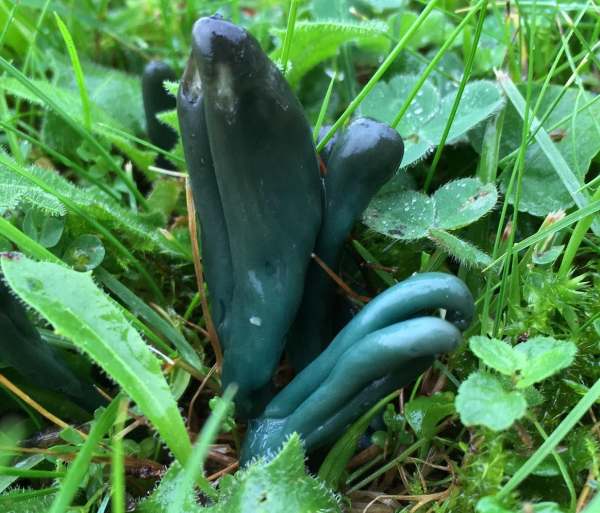
These tiny greenish earthtongues are rare finds in Britain and Ireland - not helped by their small size and their camouflage against the background of mosses and grasses.
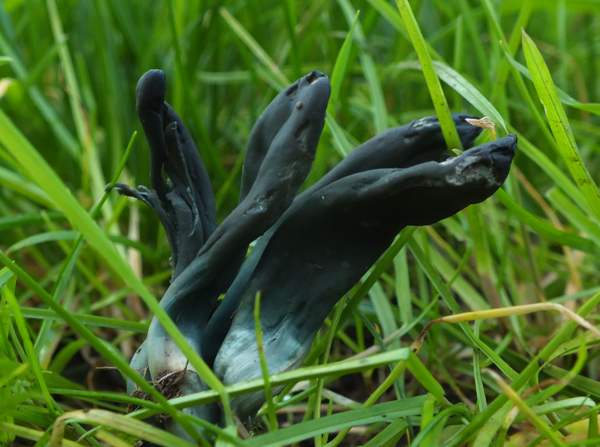
Distribution
This earthtongue occurs in Britain and Ireland in unimproved grassland areas. Microglossum pratense is also reported from many other parts of northern and central Europe including Norway and Sweden.
Taxonomic history
In 2017 this and several other new Microglossum species were delineated, using both DNA sequencing and physical characters, by European mycologists Viktor Kucera, Pavel Lizon and MIchal Tomosovsky as unique species separated from Microglossum nudipes and Microglossum olivaceum.
Etymology
Microglossum, the genus name, means small tongue, while the specific epitet comes from the Latin pratense, meaning of meadows, and refers to the grassy habitat typical of this earthtongue.
Identification guide
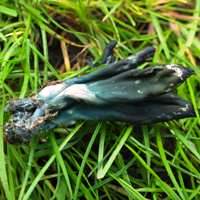 |
Fruitbody (Ascocarp)
Like many other earthtongues, this species has a flattened clavate head that does indeed look like a wrinkled tongue protruding from the earth. The laterally flattened clubs are longitudinally grooved and range from 2 to 6cm tall and typically 2 to 5mm across. Blue-green to grey-green except for a paler stem region, the surface of the ascocarp is smooth and dry. The hymenial (fertile) head comprises 50 to 75% of the ascocarp. |
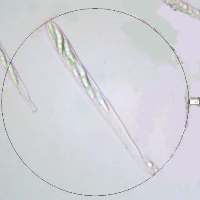 |
Asci
Clavate with rounded tips, typically 85 x 8µm; each ascus containing 8 spores. Paraphyses are filiform and typically 1 to 2µm in diameter, sometimes branching near the tips.
|
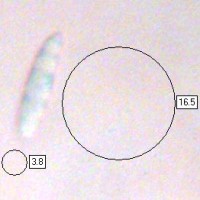 |
Spores
Fusiform, smooth, 13-17 x 4-5µm; containing several oil drops when fully mature.
Spore print
White. |
Odour/taste |
No significant taste or odour. |
Habitat & Ecological role |
Saprobic, growing in clusters in mossy grassland. |
Season |
Late summer and autumn. |
Similar species |
Microglossum olivaceum has a more clearly-delineated infertile stem. Detailed measurements of asci and spore dimensions are necessary to separate this and several other recently delineated Microglossum species.. |
Culinary Notes
Microglossum pratense is considered by some authorities to be suspect and so this earthtongue, which has no culinary value, might possibly be poisonous.
Reference Sources
Kucera, V., Lizon, P. & Tomsovsky. M. (2017). Taxonomic divergence of the green naked-stipe members of the genus Microglossum (Helotiales) Mycologia 109.
Fascinated by Fungi, 2nd Edition, Pat O'Reilly 2016, reprinted by Coch-y-bonddu Books in 2022.
Dennis, R.W.G. (1981). British Ascomycetes; Lubrecht & Cramer; ISBN: 3768205525.
Breitenbach, J. & Kränzlin, F. (1984). Fungi of Switzerland. Volume 1: Ascomycetes. Verlag Mykologia: Luzern, Switzerland.
Medardi, G. (2006). Ascomiceti d'Italia. Centro Studi Micologici: Trento.
British Mycological Society (2010). English Names for Fungi
Dictionary of the Fungi; Paul M. Kirk, Paul F. Cannon, David W. Minter and J. A. Stalpers; CABI, 2008
Taxonomic history and synonym information on these pages is drawn from many sources but in particular from the British Mycological Society's GB Checklist of Fungi.
Acknowledgements
This page includes pictures kindly contributed by Simon Harding.
Top of page...
Fascinated by Fungi. Back by popular demand, Pat O'Reilly's best-selling 450-page hardback book is available now. The latest second edition was republished with a sparkling new cover design in September 2022 by Coch-y-Bonddu Books. Full details and copies are available from the publisher's online bookshop...